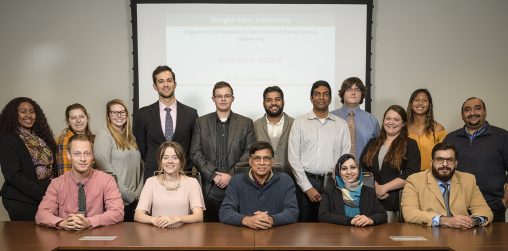
Back row, from left: Lazette Carter, Lindzy Senderak, Anne Lutz, Brandon Lease, Zachary Brooks, Tushar Goswami, Dinesh Gundapaneni, Stephen Whatley, Annie Finfrock, Andrea Gomes and Anmar Salih; front row, from left: Michael Haas, Taylor Pooler, Tarun Goswami, Farah Hamandi and Muhammad Abdulaziz. (Photo by Erin Pence)
Insights into how to make better heart pacemakers, longer lasting batteries for hearing aids and more durable plastic liners for joint replacements are among this year’s research projects for Wright State University biomedical engineering students.
The projects by the undergraduate, graduate and postdoctoral students in the College of Engineering and Computer Science are directed by Tarun Goswami, professor of biomedical, industrial and human factors engineering.
“The students are highly motivated,” said Goswami. “They are the best students we get in biomedical engineering when they come into our undergraduate program. They are not hesitant to take the step of putting in the hours and learning subjects that are very little understood.”
A project by Kelly Hunt looks for ways to make more durable hearing aid batteries, which can require frequent and costly replacement.
Anmar Salih is analyzing the performance of the batteries and wires of pacemakers, devices planted in the chest to help control heart rhythms.
Andrea Gomez is investigating ways to better deliver prescription drugs into the body by coating them with a substance that would better control how fast they dissolve.
“When you take a drug it can dissolve very quickly,” said Goswami. “If we were able to control that dissolution rate and let it time-release, it would slow down the side-effects. So we are trying to come up with some various composite forms, mixing different things together to carry the drug.”
Joint implants are often attacked by bacteria, which secrete a biofilm. Taylor Pooler is creating a mathematical model using temperature, PH and stress to predict the rate at which the biofilm grows. One failed femoral nail after removal is being investigated for the causes of failure by Stephen Whatley for his thesis.
“You want to know how fast it is going to grow so you know how fast you need to control its formation,” said Goswami.
In shoulder- and knee-replacement surgery, plastic liners are used as a buffer between bones and implants. When the liner wears out, it creates a gap that enables debris to accumulate and limit mobility of the joint. Research being done by Annemarie Finfrock and Aziz Mohammad seeks to characterize the damage that is done to the liners.
“Once you understand which mechanisms control the life of the liner, then we can work on better materials,” said Goswami.
Zach Brooks is investigating how nanoparticles from combustion engines and munitions can be inhaled through the nasal passages, change the properties of the mucous and negatively affect respiration. He is developing a microdevice to simulate the absorption of the nanoparticles while collaborating with the Air Force Research Laboratory (AFRL) and The Ohio State University via the Defense Associated Graduate Student Innovators (DAGSI) program.
Another such project is carried out by Tushar Goswami trying to develop new polymer-based material with AFRL and DAGSI.
Farah Hamandi, a Ph.D. student, is working towards understanding how the damage develops at nanometer scale in the bone that grows to cause a fracture. Dinesh Gundapaneni is further developing ankle joints that were part of his Ph.D. dissertation project funded by the Wright State Technology Commercialization Program.
Goswami predicts his students will be among the nation’s future top biomedical scientists.
“And they’re already making an impact by generating all of this new knowledge,” he said.

 Wright State partners with local universities, hospitals to expand mental health care for students
Wright State partners with local universities, hospitals to expand mental health care for students  Wright State students, first responders team up for Halloween event
Wright State students, first responders team up for Halloween event  Explore Wright State Day welcomes hundreds of future Raiders
Explore Wright State Day welcomes hundreds of future Raiders  Four Wright State nursing programs receive accreditations, including new doctorate degree
Four Wright State nursing programs receive accreditations, including new doctorate degree  Wall Street Journal ranks Wright State top public university in Ohio for student experience
Wall Street Journal ranks Wright State top public university in Ohio for student experience 